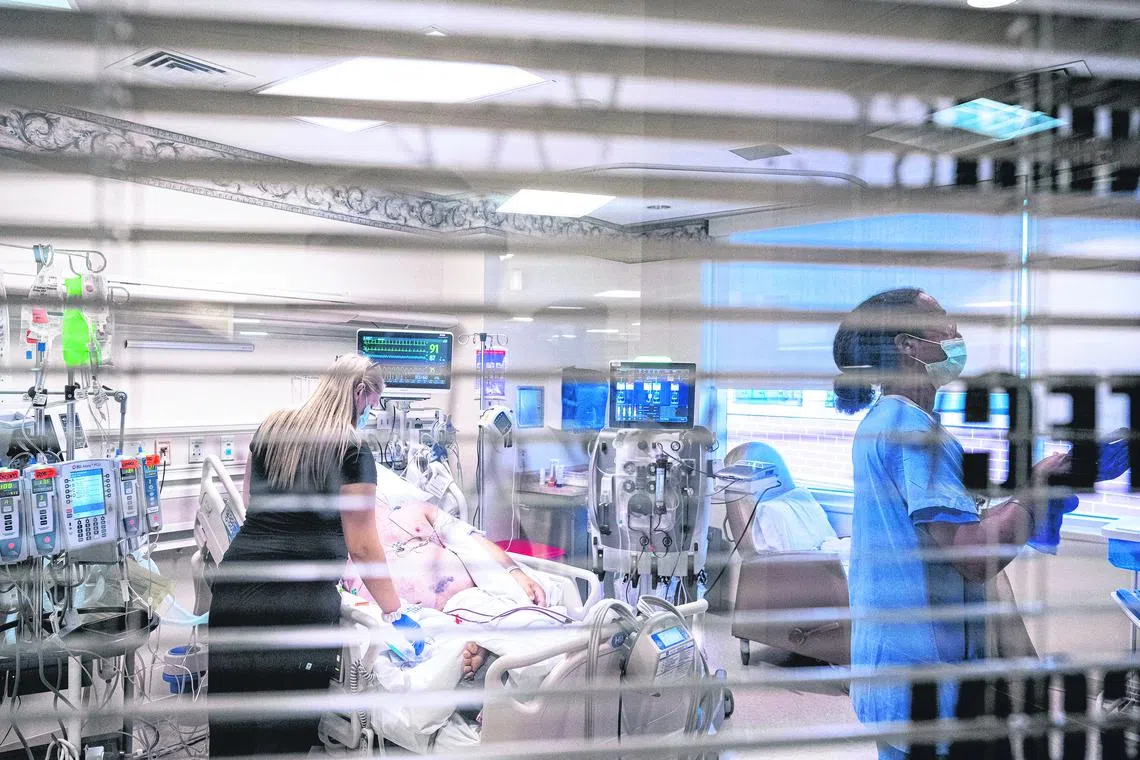Covid-19 hospitalisations in US rising, fuelled by heat and waning protection
Sign up now: Get ST's newsletters delivered to your inbox

Covid-19 hospital admissions rose 43 per cent in the US in the last week in July from a low in the week ending June 24.
PHOTO: AFP
Follow topic:
NEW YORK – Covid-19 hospitalisations are creeping up in the United States for the first time in 2023 as extreme heat keeps people indoors and protection against infection fades.
Covid-19 hospital admissions rose 43 per cent in the last week in July from a low in the week ending June 24, according to data from the US Centres for Disease Control and Prevention (CDC).
While they are still lower than at any other point over the past three years, public health officials across the country are urging caution.
As Covid-19 becomes more established, experts say occasional bumps in cases and hospital admissions will likely continue – though the virus’ future course is not set in stone.
It still poses a threat to older people and those with compromised immune systems, they caution, and can cause lingering long-Covid symptoms even among those without risk factors.
It is not a “full-blown, terrifying global outbreak, nor is it gone”, said Dr Jesse Goodman, a professor of medicine at Georgetown University. “Nor is it something that, particularly for our most vulnerable people, we can let our guard down about.”
New vaccines will be available in autumn, targeted at strains currently in circulation, and experts said it is important that vulnerable people get booster shots.
Still, access to shots has been reduced as the US has stopped purchasing them for the public from Pfizer and Moderna.
The shots are still available through healthcare providers.
At-risk people attending large gatherings should consider repeat immunisation with vaccines on the market, rather than wait for the next crop of boosters, said Dr Thomas Russo, chief of the Division of Infectious Diseases at the University of Buffalo’s medical school.
Masks also remain an option, and vulnerable people with symptoms should get tested so that they can receive antivirals like Pfizer’s Paxlovid that decrease the risk of hospitalisation and death if they are taken early in an infection, Dr Russo said.
Summer spike
Cases and hospitalisations started to rise in New York City in the middle of July, according to health department spokesman Patrick Gallahue.
In the Austin, Texas, area, wastewater sampling showed viral levels increasing over the past six weeks, the city’s health department said, an important indicator of infection levels.
Sales of at-home Covid-19 tests, another signal of concern, rose 43 per cent at Rite Aid pharmacies over the past four weeks, compared with the prior four, spokesman Catherine Carter said in an e-mail.
Pharmacy chains CVS Health and Walgreens Boots Alliance also noted heightened demand for diagnostics.
In an unusual twist for a respiratory disease, extreme heat – rather than cold – is likely fuelling the uptick. July was the hottest month on record, and heat continues to bake much of the United States in August.
As sweltering weather pushes activities and gatherings indoors, the virus has more opportunities to spread, Dr Russo said.
Meanwhile, people have taken off masks and started travelling again as cases have fallen.
It has been months since many had their last immunisation, whether through vaccination or contracting the virus, so protection against infection is waning.
At the same time, vaccines and past waves have given many people lasting protection against the worst outcomes of an infection, and the now-dominant Omicron variant appears to cause less severe disease than those that came before. Antivirals also help blunt the severity of infections.
“We’ll probably continue to see some bumps in hospitalisations,” Dr Russo said. “But I’m hoping it’s going to be more muted.”
The rate of hospital admissions is still low in every state, according to the CDC: Fewer than 10 people in every 100,000 are hospitalised with the virus each week.
Deaths are at their lowest level since March 2020, according to provisional CDC data, though they tend to increase later than hospitalisations.
Future risks
Since the first wave of Omicron cases subsided in early 2022, hospitalisations and deaths have fluctuated, but have not come close to the same heights.
Periodic bumps without widespread disruption are the “most likely scenario” going forward, Georgetown’s Dr Goodman said – but there is a lot that remains uncertain.
For one thing, it is not clear whether Covid-19 will keep gaining ground every summer.
While this is the fourth year it has done so, it is also possible that waning immunity and emerging variants have created the illusion of a pattern.
Other endemic coronaviruses that cause the common cold peak in only autumn and winter, said Dr David Weber, a professor of medicine at the University of North Carolina.
The University of Buffalo’s Dr Russo said that if immunity continues to build, the virus could almost completely disappear outside of seasonal peaks.
The opposite could also happen, if a new variant is able to cause more severe disease or spread more rapidly than the versions of the virus in circulation today.
For now, there are no signs that this is happening.
While a new strain, EG.5, recently became the most common in the US, there is no evidence it spreads more easily than those that came before, CDC spokesman Kathleen Conley said in an e-mail.
Current treatments and vaccines should continue to be effective against it, she said.
The real risk is that people do not seek out Covid-19 vaccines, tests and treatment, said Dr Michael Merson, interim chair of the Department of Global and Environmental Health at New York University.
“My biggest concern is whether people get too complacent,” he said. BLOOMBERG

